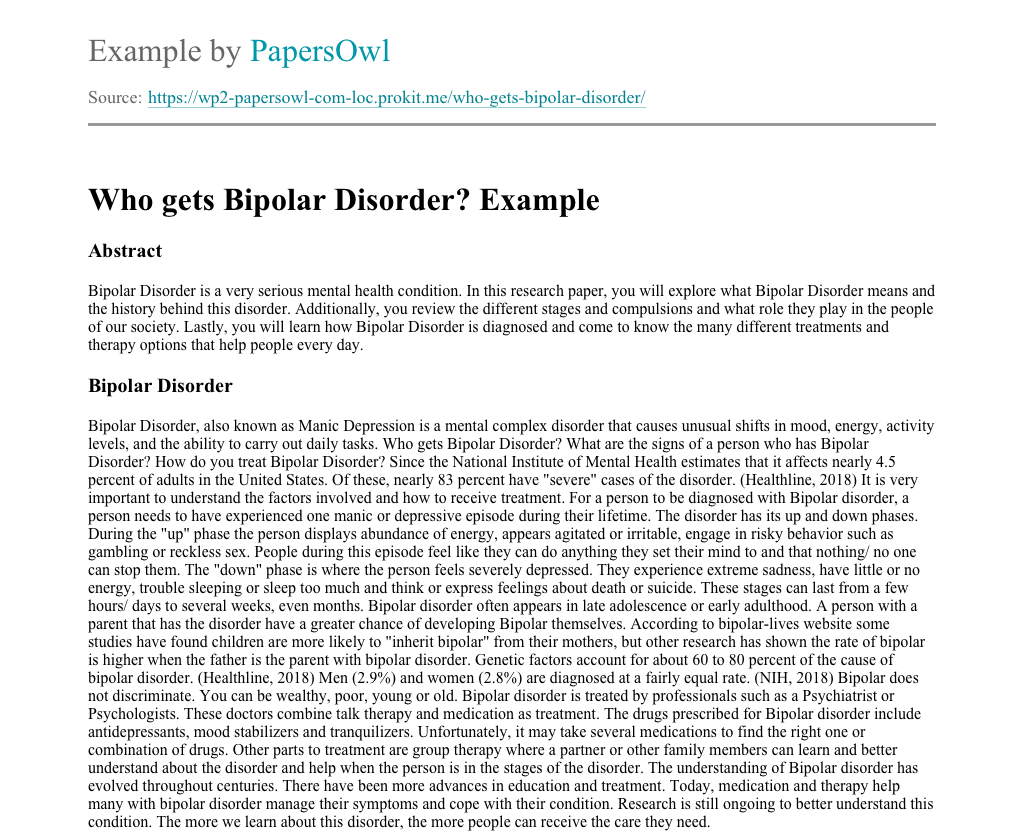
Prevalence and incidence
· Abstract and Figures. Bipolar disorder is a mental illness that causes dramatic shifts in a person’s mood, energy and ability to think clearly. People with bipolar experience high and low moods 2 Collaborative Research Team to study psychosocial issues in Bipolar Disorder (blogger.com), Vancouver, BC, Canada. 3 School of Population and Public Health, University of British Columbia, Vancouver, British Columbia, Canada. 4 Department of Psychology, University of British Columbia, Vancouver, British Columbia, Canada Bipolar Disorder is a mental illness that has many effects on the human body and mind. Known as manic-depressive disorder, bipolar disorder is most commonly found in young adults, and in some cases, children as well (Gallagher, , 35)

Introduction
2 Collaborative Research Team to study psychosocial issues in Bipolar Disorder (blogger.com), Vancouver, BC, Canada. 3 School of Population and Public Health, University of British Columbia, Vancouver, British Columbia, Canada. 4 Department of Psychology, University of British Columbia, Vancouver, British Columbia, Canada · Abstract Bipolar disorder is a chronic mental health disorder that is frequently encountered in primary care. Many patients with depression may actually have bipolar disorder. The management of bipolar disorder requires proper diagnosis and awareness or referral for appropriate pharmacologic blogger.com: Miller TH Bipolar Disorder is a mental illness that has many effects on the human body and mind. Known as manic-depressive disorder, bipolar disorder is most commonly found in young adults, and in some cases, children as well (Gallagher, , 35)
MeSH terms
· Bipolar disorder is a mental disorder that is manifested by drastic mood changes — bipolar manifests in two main extremes, namely depression, and mania (Peacock, ). Depression manifests when an individual feels tired and sad. On the other hand, mania manifests when an individual experiences periods of extreme excitement and restlessness 2 Collaborative Research Team to study psychosocial issues in Bipolar Disorder (blogger.com), Vancouver, BC, Canada. 3 School of Population and Public Health, University of British Columbia, Vancouver, British Columbia, Canada. 4 Department of Psychology, University of British Columbia, Vancouver, British Columbia, Canada Objectives: Over the past two decades, there has been tremendous growth in research regarding bipolar disorder (BD) among children and adolescents (ie, pediatric BD [PBD]). The primary purpose of this article is to distill the extant literature, dispel myths or exaggerated assertions in the field, and disseminate clinically relevant findings

Publication types
· Bipolar disorder is a mental disorder that is manifested by drastic mood changes — bipolar manifests in two main extremes, namely depression, and mania (Peacock, ). Depression manifests when an individual feels tired and sad. On the other hand, mania manifests when an individual experiences periods of extreme excitement and restlessness · Abstract Bipolar disorder is a chronic mental health disorder that is frequently encountered in primary care. Many patients with depression may actually have bipolar disorder. The management of bipolar disorder requires proper diagnosis and awareness or referral for appropriate pharmacologic blogger.com: Miller TH 2 Collaborative Research Team to study psychosocial issues in Bipolar Disorder (blogger.com), Vancouver, BC, Canada. 3 School of Population and Public Health, University of British Columbia, Vancouver, British Columbia, Canada. 4 Department of Psychology, University of British Columbia, Vancouver, British Columbia, Canada
· Abstract Bipolar disorder is a chronic mental health disorder that is frequently encountered in primary care. Many patients with depression may actually have bipolar disorder. The management of bipolar disorder requires proper diagnosis and awareness or referral for appropriate pharmacologic blogger.com: Miller TH · Abstract and Figures Introduction Patients with bipolar disorder (BD) often show comorbidity with substance use disorder (SUD) with a negative impact on clinical course, prognosis, and functioning bipolar i disorder starts on average at 18 years and bipolar ii disorder at 22 years. 9, 14 a community study using the mood disorder questionnaire (mdq) revealed a prevalence of percent. 15 the national comorbidity study showed onset typically between 18 and 44, with higher rates between 18 and 34 than 35 and 1 in a survey of members of Author: Donald M Hilty, Martin H Leamon, Russell F Lim, Rosemary H Kelly, Robert E Hales

No comments:
Post a Comment